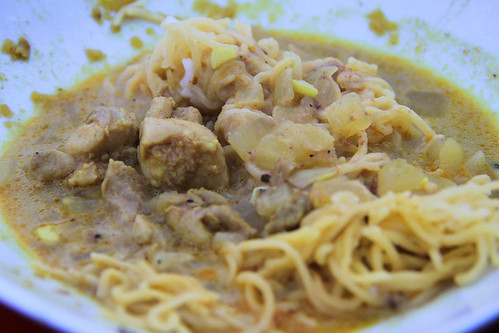
Pakistan was, until 1947, part of India. While the intention was to create a new country for Muslims, the dividing line was in many ways arbitrary, ill-informed, or simply doomed, given that religious communities intermixed plenty. In particular, the huge state of Punjab was split in two. Then, millions of people moved across the lines in both directions (or died in the attempt) to the country that reflected their religion. Both of these factors explain why Pakistani food seems so similar to the North Indian food we know: they were once the same country — in fact, much of the Indian food in the US is Punjabi style — and many immigrants brought foods from other parts of what's now the Republic of India.
This meal fell during Ramadan, which posed both an opportunity and a challenge. I was excited to have a guiding principle, since the food after the fast is often ritualized. But the challenge was the risk of offense by indulging in all the post-fast treats without observing the fast itself. Several Muslims assured me not to worry, and in fact a Pakistani member of the US Embassy's staff in Islamabad graciously gave me plenty of advice on what to prepare. (Thank you Erin for the connection!) In addition to the below recipes, we began the meal with the traditional fast-breaking food: dates.

Our guest of honor was Kal, a previous Nosher, who was born in Afghanistan but spent a decade as a refugee in Pakistan before coming to the US. We also had Katherine, Carlo, Marsha, Robert, Chie, Lyall, Eileen, and friends.
Rooh Afza | Sweet drink

This is the fast-breaking drink of Pakistan. It's a commercial syrup that's mixed with water — what's known in British English as a squash — and much improved with lime. (Some mix it with milk.) It's was a completely unfamiliar flavor sensation, a blend of all sorts of fruits, herbs, and spices with the most recognizable note being rose. It wasn't really my thing but I can see this sugary drink being extremely quenching after a hot day with nothing touching your lips after sunrise.
Fruit chaat | Spiced fruit salad | Recipe

Some cultures have figured out that bold spices are a fantastic complement for fruit. A shake of Tajín, a Mexican blend of chili, dried lime juice and salt, perks up mango, pineapple, and just about any other fruit or raw vegetable. In Morocco, they often serve orange slices with cinnamon. And now we here have Pakistan's contribution to the genre. The blend is more complex than the others I've seen before, with elements of sour, salty, pungent, and minerally. It would certainly perk up less-than-perfect fruit, but when it's really good and in season like here, it's pretty tasty and addictive and a failsafe appetite stimulant.
Dahi bhallay | Black gram fritters in yogurt sauce | Recipe

From a Western perspective, what's curious about this dish is how the fritters are soaked in water after frying. Why let all that great crisp go? So they can absorb the yogurt and tamarind dressing that makes them oh so tasty. This dish is quite a bit of effort with the frying, so it's not the sort of thing I'd just go about making on a weeknight, but it was a flavorsome treat.
Sai bhaji | Spinach and legume stew | Recipe

This straightforward curry is a staple of Sindh, the province of southeastern Pakistan. It's pretty straightforward to make, a stew of greens, tomatoes, a mild amount of spice, and lentils or split chickpeas. Unfortunately, I felt like what came out was kind of what went in: it was perfectly edible, but just not terribly exciting, and it's unclear to me if I did something wrong or it's simply meant to be that way. There's no doubt, however, that this is one of the most nutritious dishes I have cooked for a Nosh!
Karahi gosht | Goat simmered in tomato sauce | Recipe

This recipe calls for mutton, and in the Subcontinent, mutton means goat. (Not the meat of mature sheep, as in the UK.) I like goat, and good goat can be hard to find, so I ended up buying an entire goat from a small-scale butcher. I used two legs for this meal; the rest is in the chest freezer.
Now, to the dish. This one was a winner! A really straightforward, low effort technique — simmer the meat until it's cooked, then put in sauce stuff and let it cook until tasty. You don't even have to toast spices or do any other tedious prep, just dump and simmer. Even though it ended up more liquidy than pasty like it should have (was my yogurt too runny, or tomatoes too watery?), the flavors were excellent and bright and I oughtta make this one again.
Mutton nihari | Goat stew | Recipe

I couldn't decide which goat dish to cook, so I made both. If you're only cooking one, choose the other. The nihari was totally fine, but despite all the spices, turned out sorta plain, which was a disappointment after cooking for half a day. As with the saibhaji, I'm not sure if there was an error along the way, or that's just how it's meant to be.
Chicken sajji | Slow-roasted chicken with spiced rice | Recipe

This recipe represents Balochistan, a mostly arid province bordering Afghanistan and Iran. This dish is a whole lot more like what I know of Gulf cuisine, with the animal roasted rather than cooked in a sauce. What's more, the rice is parboiled, which is a technique I associate with Persian food. (A stickler will note that rice in biryani, a pinnacle of Indian cuisine, is similarly boiled hard until nearly done. I will rejoinder that, in fact. biryani is of Persian origin.) Anyway, I loved this. Cardamom, vinegar, dried pomegranate, and even dates all feature, and make for one scrumptious whole.





















